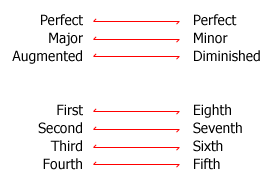Before reading this music theory lesson, please make sure you’re comfortable with the concept of generic intervals and specific intervals.
In music, inverting refers to the process of moving the bottom note from a specific group, up by an octave. When you invert an interval the new interval changes. This may sound complicated at first, but it’s actually not as these changes follow a certain set of simple rules as outlined below:

Inverting intervals
Let’s now look at an example of inverting intervals to clarify how these rules should be followed:

Example of inverting an interval
If you are familiar with the previous lesson, specific intervals, then you will be able to see that the interval before the inversion is a diminished fourth, as it is a fourth with 4 semitones difference. Now, according to the set of rules outlined in the first illustration, a fourth will always invert to a fifth and a diminished will always invert to an augmented. Therefore we can determine that if we invert a diminished fourth it’ll in fact end up as an augmented fifth.
- Want to improve your guitar playing?
-
These lessons have been written by me, a guitar enthuthiast. I've written them to the best of my abilities, but I'm no guitar teacher!
If you want award-winning, well structured but inexpensive lessons, I strongly recommend you check out Guitar Tricks. They have great range of video guitar lessons from numerous coaches specialising in a wide range of styles.
I've seen their videos, and they're great. With these guys, I'm confident you'll be improving in no time!
